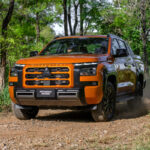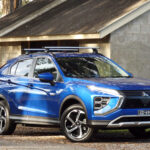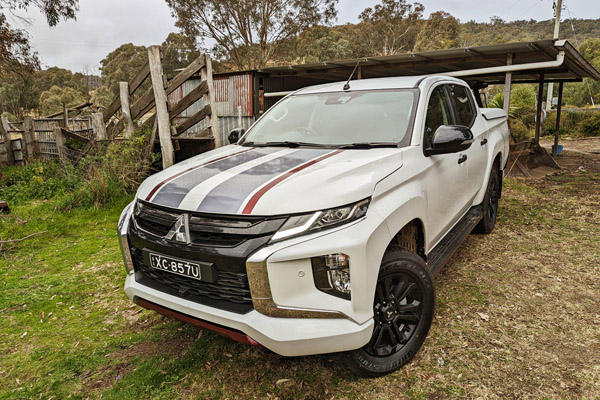
The latest Mitsubishi Triton acquires some fashionable black bits. There’s been a few
along the way and this probably won’t be the last.
Mitsubishi has become the master of squeezing the most out of its long-serving model
lines with minor upgrades and special editions.
The current Triton dates back to 2015, but was facelifted in 2019, with changes to front
and rear designs – and was the last version that we drove.
There’s an all-new Triton on the way, due for launch later this month overseas, and that
means clearing the decks with special editions like this one that are designed to stimulate
sales.
Based on the GLS with Deluxe options pack, Triton Sport Limited Edition features a bunch
of mainly black extras to make it more appealing — both visually and functionally.
STYLING
Sport is available in dual cab format only with a tub on the back and choice of white or
black, with a black wheels and trim.
Skid plate, side steps and rear apron feature maroon accents, while the bonnet and
tailgate get some tasteful GT stripes (not the roof or tonneau cover though).
Inside, the cabin is decked out in a combination of black leather with red stitching.
Triton is priced from $30,740 plus on-roads for the bare bones 4×2 GLX single cab chassis
with a manual transmission.
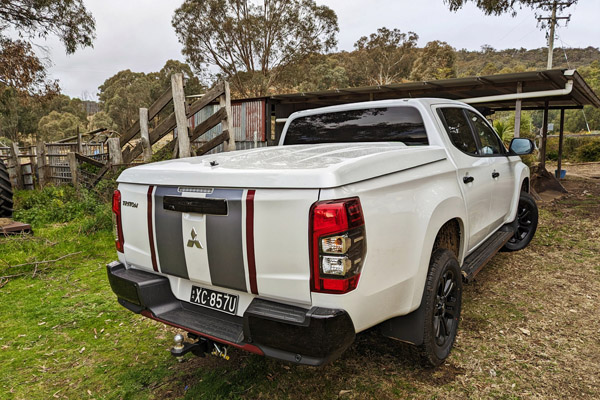
The family-friendly 4×4 dual cab range kicks off with the 4×2 GLX with auto, from $44,240
driveaway (4×4 version takes the price to $48,240).
This is followed in quick succession by GLX+, GLX-R, GLS, GLS Sport Edition, and range-
topping GSR with the works for $65,740 driveaway.
Our test vehicle, the Sport Edition with a six-speed auto, is based on the GLS and priced
from $60,926 driveaway — that’s $4500 more than GLS.
In addition to the trim and spin, Sport adds a power-adjust driver’s seat, heated front seats,
leather door inserts and a 360-degree camera.
Two-zone climate air is supplemented by a roof-mounted blower to distribute air to the rear
of the cabin.
Other features include LED headlights, auto high beam, auto lights and wipers, auto
dimming rear view mirror, cruise control, speed limiter, side steps, front and rear parking
sensors, auto high beam, auto lights and wipers and an auto dimming rear view mirror.
Although the test vehicle was presented with a matching hard tonneau, protective tray
liner, tow bar and mud mats – these items are in fact extra.
A 10-year/200,000km warranty applies to vehicles that are serviced exclusively within the
Mitsubishi dealer network. Otherwise, it drops down to five years and 100,000 kilometres.
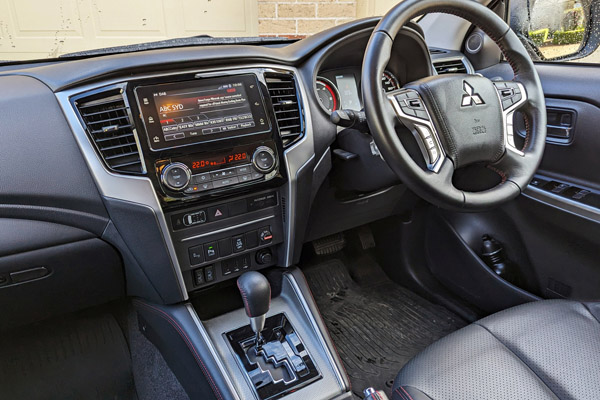
INFOTAINMENT
Infotainment consists of a 7.0-inch inset touchscreen, with Bluetooth, AM/FM and DAB+
digital radio, wired Apple CarPlay and Android Auto connectivity, with six-speaker audio.
Unfortunately, satellite navigation is not part of the deal with any grade, which is weird
given the last time we drove Triton it was.
It’s alright to leave things off the list, but it’s not recommended to remove them.
There’s also two USB, an HDMI port and 12-volt socket at front of the centre console, and
another two USB ports in the rear, plus a 12-volt outlet inside the console box — but no
similar outlet for fridges in the tub.
ENGINES / TRANSMISSIONS
Triton is powered across the board by a 2.4-litre turbocharged diesel engine, with a choice
of 4×2 or 4×4, six-speed manual or six-speed automatic transmissions.
The diesel produces 133kW of power at 3500 rpm and 430Nm of torque, the latter at only
2500 rpm.
SAFETY
Safety consists of seven airbags, including a knee bag for the driver, rear view and 360-
degree cameras, plus autonomous emergency braking with pedestrian detection.
There’s also Lane Departure Warning (LDW), Blind Spot Warning (BSW), Rear Cross
Traffic Alert (RCTA), Lane Change Assist (LCA) and Ultrasonic misacceleration Mitigation
System (UMS).
Auto braking works up to a speed of 80km/h with stationary objects or 200km/h if they’re
moving.
The mis-acceleration priced reduces the chance and severity of hitting obstacles up to four
metres away if the driver mistakenly presses the accelerator instead of the brake, at
speeds of up to 10km/h.
Sounds good so far, but – and it’s a big BUT – Triton’s five-star safety rating has expired
and it needs to be re-tested under the current regime. It was last tested in 2015 and time,
as they say, has moved on since then.
DRIVING
At 5305mm long, Triton is up there in terms of size, yet smaller than others.
Head, leg and shoulder room are adequate without being squeezy.
The rear seats will accommodate a couple of teenagers, but three full grown adults could
be pushing the friendship.
Side steps and grab handles are provided for each door to make getting in and out easier.
The tub itself measures 1520mm in length, 1470mm in width and 475mm in depth and can
carry just over 900kg, while it’s rated to tow a 3100kg braked trailer.
Mitsubishi’s Super Select II all-wheel-drive system lets you choose between rear- or all-
wheel drive, high or low range and there is also a lockable rear diff.
Steering wheel paddles are provided if you want to shift gears manually, with drive modes
for rock, gravel, mud/snow and sand.
The standard tyres on the Sport are road-biased, but okay for most needs.
Triton is a likeable enough ute.
It’s easy to drive, with a reasonable 11.8 metre turning circle and feels unpretentious, even
replete with stripes.
On anything but well-formed tarmac, however, the ride quickly deteriorates, becoming
jarring and jiggly with plenty of backlash transmitted through the steering wheel.
This backlash means you need to keep a close eye on the road.
Looking at the old-style analogue instrument panel, it’s remarkable how little has changed
over the years.
The touchscreen lacks a physical volume control or tuning dial for the radio and the
instrument cluster does not have a digital speed display or speed-sign recognition.
But at least the instruments are clear and easy to read.
Sadly, it misses out on adaptive cruise control too which we’ve grown to like in recent
years.
Off road, Triton is more than competent, even with road-biased rubber.
With 220mm of ground clearance, low range and a locking rear diff that can be activated in
high or low range, it has all the makings for adventure.
We took the ute paddock bashing for an hour or so over mud, loose rock and the odd
water crossing — and it didn’t miss a beat.
The lack of built-in navigation is problematic and getting Android Auto up and running
proved to be a trial as usual.
And, let’s not forget, when you run out of phone reception, you also run out of directions.
We had a bit of fun trying to get Hey Google to play music, specifically children’s songs.
While it understood requests, what emerged from the speakers was certainly not what we
had asked for.
In the end it became a bit of a game.
Opening and closing the big boot lid is a bit hit and miss too. Sometimes it was reluctant to
unlock and when it came to closing, unless you pushed down with a hand extended to
each corner, one side tended to remain unlatched (which wasn’t evident).
Fuel consumption ranges from 7.8L/100km to 8.6L/100km, depending on grade and
transmission. Our six-speed Sport automatic is good for 8.6L/100km.
With a 75-litre tank, it doesn’t seem to use much fuel either.
We clocked up about 600km of mainly country driving over the course of a few days.
I’d like to quantify this, but of course I’d forgotten about Mitsubishi’s crazy trip computer
which continually resets no matter what you tell it.
SUMMING UP
It might be a bit long in the tooth, but the Triton has always traded on value for money and
the Sport Edition is no exception.
We like to do a bit of country travelling and a 4×4 ute with a lockable tray is an attractive
proposition, particularly with the ability to go off road and tow a van.
Then there’s the 10-year warranty (so what if it means servicing the car where you bought
it).
Maybe this could be the one?
RATINGS:
Looks: 8/10
Performance: 7.5/10
Safety: 6/10
Thirst: 7.5/10
Practicality: 7.5/10
Comfort: 7/10
Tech: 7/10
Value: 7/10
Overall: 7.2/10
AT A GLANCE
MODEL LINE-UP
Triton GLX from $44,240 (Drive away)
Triton GLX-R from $47,490 (Drive away)
Triton GLX+ from $48,490 (Drive away)
Triton GLS from $53,240 (Drive away)
Triton Sport Edition from $60,926 (Drive away)
Triton GSR from $65,740 (Drive away)
Note: These prices do not include government or dealer delivery charges. Contact your
local Mitsubishi dealer for drive-away prices.
.
SPECIFICATIONS (Triton Sport 2.4L 4-cylinder turbo-diesel, six-speed automatic,
selectable 4×4 dual cab ute)
ENGINE:
Capacity: 2.4 litres
Configuration: Four cylinders inline
Combined Maximum Power: 133 kW @ 3500 rpm
Combined Maximum Torque: 430 Nm @ 2500 rpm
Fuel Type: Diesel
Combined Fuel Cycle (ADR 81/02): 8.6 L/100km
CO2 Emissions: 225 g/km
DRIVELINE: Six-speed automatic, selectable 4×4
DIMENSIONS, WEIGHT AND CAPACITIES:
Length: 5305 mm
Wheelbase: 3000 mm
Width: 1815 mm
Height: 1795 mm
Turning Circle: 11.8 metres
Kerb mass: 1991 kg
Fuel Tank Capacity: 75 litres
BRAKES:
Front: Ventilated Disc
Rear: Drum
STANDARD WARRANTY:
10 years / 200,000km




